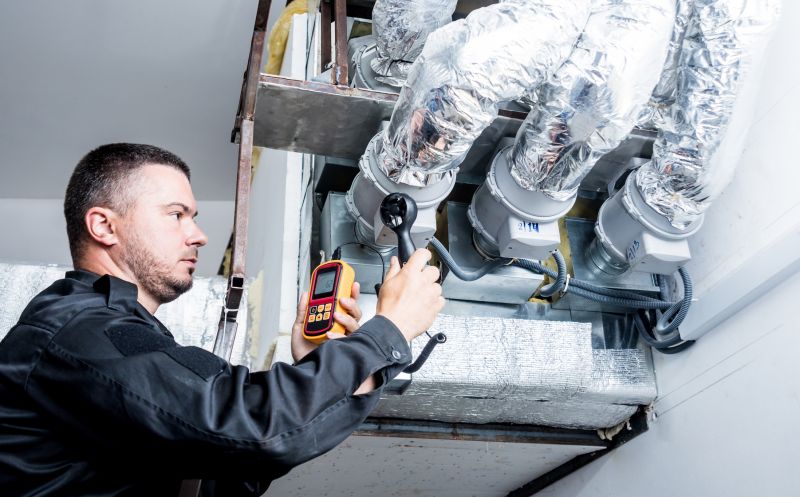Ultimate Selection Of Duct Testing Instruments For Professionals
Browse a comprehensive range of duct testing equipment crafted to meet the needs of HVAC experts and contractors.
 Duct testing products are essential tools used by HVAC professionals and building inspectors to evaluate the integrity, efficiency, and safety of duct systems. These tools help identify leaks, measure airflow, and ensure that ventilation systems operate as intended. Accurate testing can improve indoor air quality, optimize energy consumption, and prevent costly repairs caused by undetected leaks or blockages. Whether for residential, commercial, or industrial applications, selecting the right duct testing equipment is crucial for obtaining reliable results.
Duct testing products are essential tools used by HVAC professionals and building inspectors to evaluate the integrity, efficiency, and safety of duct systems. These tools help identify leaks, measure airflow, and ensure that ventilation systems operate as intended. Accurate testing can improve indoor air quality, optimize energy consumption, and prevent costly repairs caused by undetected leaks or blockages. Whether for residential, commercial, or industrial applications, selecting the right duct testing equipment is crucial for obtaining reliable results.
Types of Products For Duct Testings
Handheld Anemometers
Portable devices used to measure airflow velocity within ducts, ideal for quick assessments.
Digital Manometers
Electronic pressure gauges designed to measure static and differential pressure in duct systems.
Smoke Testing Kits
Tools that release visible smoke to identify leaks and airflow issues within ductwork.
Flow Hoods
Devices placed over vents and registers to measure volumetric airflow directly at air outlets.
Anemometer Blades
Replaceable blades attached to handheld units for measuring airspeed in ducts.
Pressure Pan Kits
Accessories used with manometers to measure pressure differences across duct sections.
Leak Detection Spray
Specialized sprays that highlight leaks when used with smoke or airflow tests.
Anemometer Probes
Probes that extend into ducts to measure airflow velocity at various points.
Calibration Kits
Sets that help calibrate testing devices for consistent and accurate measurements.
Portable Duct Blower Fans
Compact fans used to test duct system pressure and airflow by creating controlled airflow conditions.
Thermal Anemometers
Devices that measure airflow using temperature differences, suitable for various duct types.
Duct Inspection Cameras
Flexible cameras for visual inspection inside ducts to identify physical issues or obstructions.
Flow Measurement Sensors
Advanced sensors that provide real-time airflow data for detailed analysis.
Pressure Differential Meters
Instruments that measure pressure differences across filters, dampers, or duct sections.
Duct Test Port Kits
Setups that allow for easy access and testing at various points within duct systems.
Popular Choices
Widely used for measuring airflow velocity and volume in ducts, appreciated for their portability and ease of use.
Commonly employed for static and differential pressure measurements, suitable for various duct applications.
Popular for measuring airflow at vents and registers, providing direct volumetric flow readings.
Effective for visualizing leaks and airflow issues, often used during inspection and maintenance.
Frequently chosen for testing duct system performance under controlled airflow conditions.
Popular for inspecting inaccessible areas inside ducts and identifying potential issues visually.
Valued for their ability to measure airflow based on temperature differences, suitable for various duct types.
Commonly used to ensure measurement devices maintain accuracy over time.
Popular for performing pressure tests to detect leaks and verify duct integrity.
Often used in advanced diagnostic setups for continuous airflow monitoring.
Widely utilized for detailed internal inspections of ductwork for physical issues.
Commonly used during testing to identify leaks by highlighting airflow escapes.
Modern duct testing devices come in various forms, including handheld instruments, electronic meters, and comprehensive testing kits. Handheld devices are portable and user-friendly, suitable for quick assessments or troubleshooting. Electronic meters often feature digital displays, data logging capabilities, and multiple measurement functions, providing detailed insights into duct performance. Advanced testing kits may include multiple accessories such as adapters, sensors, and calibration tools to accommodate different duct sizes and configurations.
When choosing duct testing products, considerations such as ease of use, measurement accuracy, durability, and compatibility with existing systems are important. Some devices are designed for specific testing methods like pressure testing or airflow measurement, while others offer multifunctional capabilities. Proper calibration and maintenance are necessary to ensure ongoing accuracy. Investing in quality tools can lead to more precise diagnostics and help maintain high standards in HVAC system performance and safety.
Key Buying Considerations
- Measurement accuracy and calibration requirements
- Ease of use and user interface design
- Portability and weight for on-site testing
- Compatibility with different duct sizes and types
- Durability and build quality for long-term use
- Battery life and power options
- Data logging and connectivity features
- Versatility of measurement functions (airflow, pressure, leak detection)
- Availability of replacement parts and accessories
- Ease of calibration and maintenance
- Cost and overall value for the intended application
- Brand reputation and user reviews
- Compliance with industry standards and certifications
- Warranty and customer support options
- Size and portability for confined spaces
